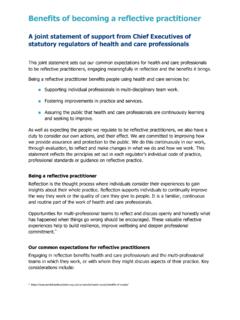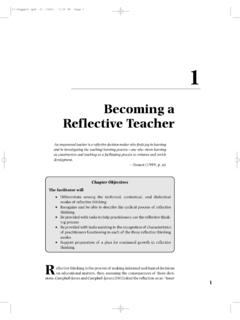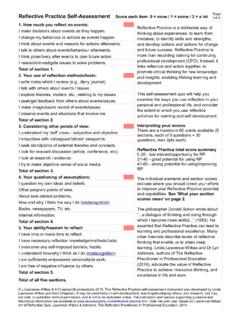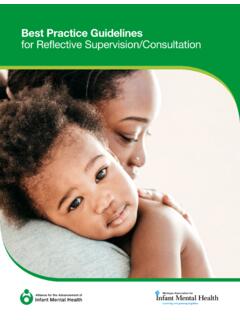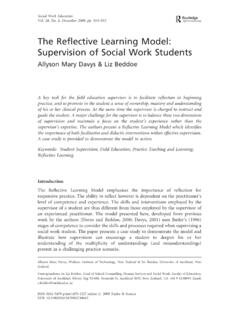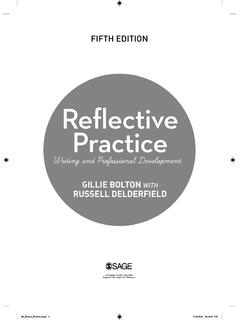Transcription of Reflective practice - Framework
1 Reflective practice What is Reflective practice ? Reflective practice describes a systematic approach to reflection that involves creating a habit, structure and routine around reflecting on our experiences. Reflective practice can be an individual or a group experience. Whether you choose to learn from experience as an individual or with colleagues depends on the purpose of your reflection your personal learning agenda. For example, if you are working on a Learning Question, you may find it more helpful to explore and share your thinking together with your colleagues. If you need to make sense out of a week s worth of meetings, activities and frustrations in order to decide how to proceed with a project then you might choose to reflect on these individually first before sharing your thoughts with your colleagues.
2 If, on the other hand, you want to consider your role in a recent conflict with a colleague, you may choose to do this alone in order to work out how best to handle similar situations in the future. Benefits of Reflective practice As well as benefiting us as individuals, Reflective practice can also benefit our teams. Specifically, Reflective practice can help teams1 to: Uncover new information by sharing ideas with others, individuals memories can be triggered and new information and more refined insights can emerge; Limit biases a thorough and critical discussion about information (impressions and data) means it is cross-checked and we can point out when we feel an issue has been represented inaccurately; Build a clear picture of a situation / event / process and reach consensus by discussing data, contradictions and gaps, these can be understood and gaps can be filled; Ensure well-reasoned, meaningful actions joint analysis can reveal the structural causes of problems and solutions, leading to better planning and action.
3 Identify good practices by examining what has worked well and reflecting on why and how, we can build up an in-depth understanding of good practice ; Facilitate action that has broad ownership the more people that understand the causes and nature of issues, the more this can motivate people to invest in making change happen. 1 Source: IFAD Guide to Project M&E, Section 8 (Reflecting Critically to Improve Action), p8-4 Available for download from: This work is licenced under a Creative Commons Attribution Non-Commercial Share Alike licence. Becoming a Reflective practitioner A Reflective practitioner is someone who takes the time during or after their work to step back and make sense of what has happened, and why. Reflective practitioners try to better understand the often unstated personal theories of how change happens2 that guide their actions.
4 Becoming more conscious of these personal theories of change often involves the Reflective practitioner in challenging their own assumptions and the assumptions of colleagues. Reflective practitioners may reflect on action or reflect in action . Reflecting on action means reflecting after the event. In other words, reflecting on action is distanced in time and space from the original experience. Reflecting in action involves thinking on your feet during the activity itself and is more challenging but also more immediately rewarding as it can influence decisions and actions as they unfold in real time. Reflecting on action and reflecting in action both demand a high level of individual competence. Reflective practitioners need four key competences: Self Knowledge, Inquisitiveness, Emotional Intelligence, and Critical Thinking.
5 Self knowledge Self knowledge involves understanding and having insight into one s self-worth, motives, character and capabilities. Self Knowledge falls under three categories: Knowledge of what you can do your capabilities Knowledge of what you know and what you understand your knowledge and wisdom Knowledge of who you are and who you wish to be your character, motives, identity and plans for the future The deeper the individual s self-knowledge, the greater their potential for in-depth reflection and learning. Emotional intelligence Emotional intelligence is the ability to identify, assess and manage one s own emotions and those of other individuals and groups. Emotional intelligence comprises five domains: Self-Awareness, Self-Regulation, Self-Motivation, Social Awareness and Social Skills.
6 The first three are personal domains and the other two are social domains. Self-Awareness comprises: (i) Emotional awareness: Recognizing one s emotions and the effects these have on yourself and others. (ii) Accurate self-assessment: Knowing one s strengths and limits. (iii) Self-confidence: Sureness about one s self-worth and capabilities. Self-Regulation involves: (i) Self-control: Managing disruptive emotions and impulses. (ii) Trustworthiness: Maintaining standards of honesty and integrity. (iii) Conscientiousness: Taking responsibility for personal performance. (iv) Adaptability: Flexibility in handling change. (v) Innovativeness: Being comfortable with and open to new ideas and new information. 2 These personal theories of how change happens are different from the Theories of Change (ToC) that guide the design and implementation of projects and programmes.
7 Self-Motivation consists of: (i) Achievement drive: Striving to improve or meet a standard of excellence. (ii) Commitment: Aligning with the goals of the group or organization. (iii) Initiative: Readiness to act on opportunities. (iv) Optimism: Persistence in pursuing goals despite obstacles and setbacks. Social Awareness requires: (i) Empathy: Sensing others feelings and perspective, and taking an active interest in their concerns. (ii) Service orientation: Anticipating, recognizing, and meeting the needs of others. (iii) Developing others: Sensing what others need in order to develop, and strengthening their abilities. (iv) Leveraging diversity: Cultivating opportunities through diverse people. (v) Political awareness: Reading a group s emotional currents and power relationships.
8 Social Skills include: (i) Influence: Using effective tactics for persuasion. (ii) Communication: Sending clear and convincing messages. (iii) Leadership: Inspiring and guiding groups and people. (iv) Change catalyst: Initiating or managing change. (v) Conflict management: Negotiating and resolving disagreements. (vi) Building bonds: Nurturing instrumental relationships. (vii) Collaboration and cooperation: Working with others toward shared goals. (viii) Team capabilities: Creating group synergy in pursuing collective goals. Inquisitiveness is the willingness to be curious and inquiring about your work and your organisation, for example by asking yourself questions. Inquisitiveness involves: Looking for patterns and connections Questioning current knowledge and understanding Building on your existing understanding Being curious about underlying causes Uncovering issues on which to focus further inquiry Critical thinking Critical thinking is the application of logical principles, rigorous standards of evidence, and careful reasoning to the analysis and discussion of claims, beliefs, and challenges.
9 Critical thinking involves: Examining issues from different perspectives Taking a systems approach Seeing beyond established ways of thinking Identifying larger patterns, dynamics and interrelationships Challenging assumptions Identifying the root causes of issues Being aware of cultural and contextual issues Acknowledging intuition, emotions and empathy In order to be a Reflective practitioner , we need to develop these four competence areas. Tools for Reflective practice The most useful tools for Reflective practice are based on questions, stories and dialogue. Questions Because Reflective practice is structured around inquiry, questions are key to effective Reflective practice . A simple tool that uses questions for Reflective practice is the After Action Review (AAR).
10 An After Action Review involves reflecting on an activity, work-project, event or task using the following simple questions: 1. What was planned? 2. What actually happened? 3. Why did it happen? 4. What lessons can we learn for next time? For most situations, the After Action Review questions are powerful enough to generate useful insights. However, if you really want to reflect in-depth on an activity, you could use some or all of the questions in the three-stage reflection process described in the flowchart below. Stories are narrative accounts of experience. Stories make reflection easier because they enable us to relive our experience. Critical Incident Review is a story-based tool that can be used systematically to examine, reflect on, and learn from positive and negative critical incidents.

